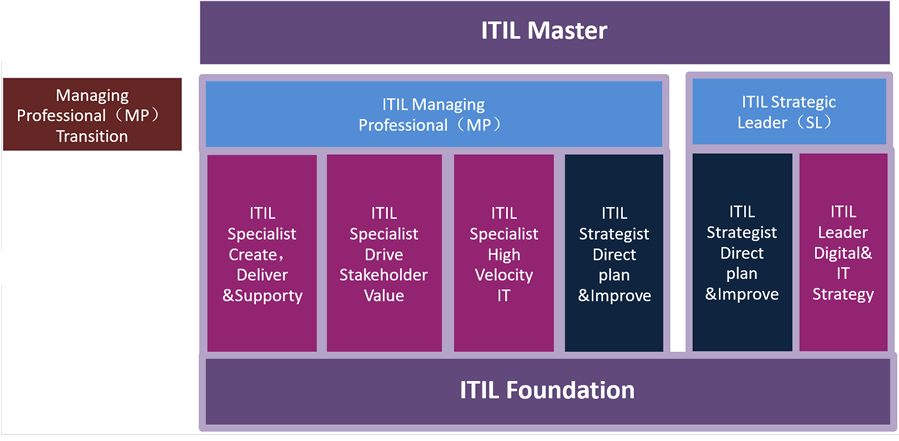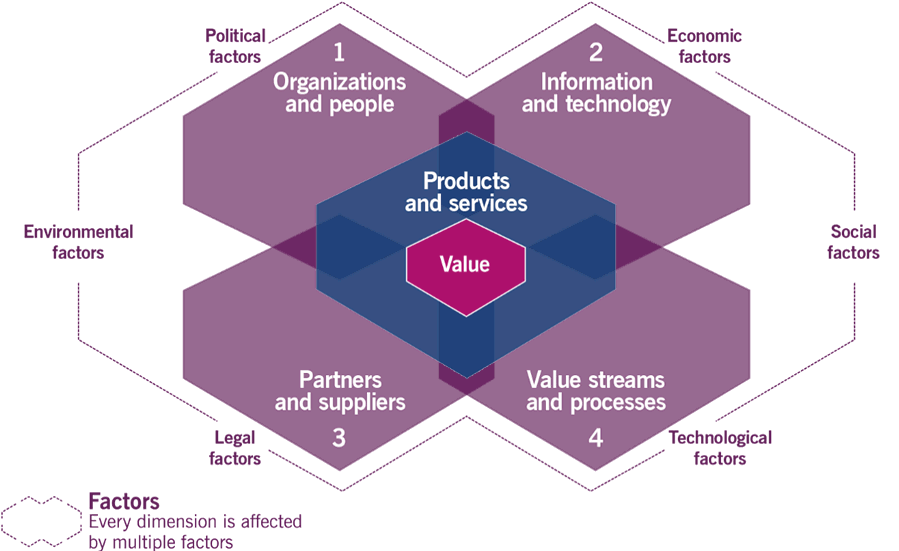
此更新的官方新名称将是ITIL®4而不是ITIL®v4。尽管当前版本被称为ITIL®v3,但新更新将被称为ITIL®4,因此没有'v'。
AXELOS实践自2017年11月宣布,使用广泛的服务管理框架ITIL®将在2018年进行更新,包括来自全球150位内容编写者,审阅者和贡献者,2,000多名志愿者。该更新将包括有关如何在日益复杂的现代环境中塑造和定制IT管理战略的实用指南。
ITIL®框架的所有者AXELOS已经通过此ITIL 4更新流程改变了他的传统方法。为了比以往任何时候都更加重要,全球行业专家和用户社区参与了此更新的开发。仅研究阶段就花了一年多的时间。成千上万的ITIL从业者提供了他们的意见。用户社区和受尊敬的专家共同努力的结果是一个平衡,深入的框架。
ITIL®4对组织面对新的服务管理所带来的挑战以及使用潜在的现代技术提供指导,它的目的是做一个灵活、协调和集成的系统,以有效地治理和管理IT使能(IT-enabled)的服务。
ITIL®4认证计划:
ITIL® 4 将推出基础级别,计划于2019年第一季度推出,其余级别将于2019年下半年发布,提供清晰的路径让从业者继续他们的ITIL旅程。
ITIL® 4的认证体系与ITIL®V3/2011的认证体系,都是由初级、中级、高级和大师级(Master)这四个级别组成。

ITIL®4基础培训:
我们在中国提供ITIL及相关课程培训、管理实践咨询已经有10年了。对ITIL® 4认证体系抱极大的热诚和专注!
本门课程是英国AXELOS引入的第一门ITIL 4课程。ITIL 4基础培训是跨入其它诸等级的强制课程。
后续课程分别是:ITIL®管理专家(MP),需要完成四门实践者级课程;ITIL战略领导者(SL),需要完成两门实践者级课程。

ITIL®4 基础课程简介:
这是一个两天的课程,本课程为全新的IT服务管理基础认证服务(Foundation Certificate In IT Service Management).
本课程引入ITIL® 4,协助学员理解IT服务管理的服务价值体系(IT Service Management through a Service Value System (SVS)).
ITIL® v3和ITIL ®4的关键区别是什么呢?简而言之,ITIL v3描述服务管理和26个流程及运营职能,其按照ITIL服务生命周期的五个阶段分布。ITIL v3的内容依然是很值得参考的。而ITIL ®4提出了演进版的服务价值体系(Service Value System (SVS)),它提供了全面的端到端的全景图关于如何给业务带来价值,它同时也吸收了Cloud,Lean IT,Agile和DevOps的模型。

两天的培训涉及的主要内容包括:
| 第一天 | 对ITIL® v3的5步生命周期模型的快速回顾,以及ITIL® v3到ITIL ®4的匹配 |
| ITIL® 4的7项指导原则(Guiding Principles) | |
| ITIL®4全新的服务价值链 | |
| 服务管理的4个维度(four dimensions) | |
| 第二天 | 34个ITIL®实践,特别关注其中的18个(基础阶段) |
| Lean IT、Agile、DevOps和组织变革管理的关键概念,以及为何它们对业务价值交付如此重要 |
课程设置:
| ITIL® 4 Foundation 英文目录 | 中文目录 |
| 1 Introduction | 介绍 |
| 1.1 IT service management in the modern world | 现今世界的IT服务管理 |
| 1.2 About ITIL® 4 | 关于ITIL®4 |
| 1.3 The structure and benefits of the ITIL®4 framework | ITIL®4 框架的结构与益处 |
| 1.3.1 The ITIL®SVS | ITIL®服务价值体系 |
| 1.3.2 The four dimensions model | 四维度模型 |
| 2 Key concepts of service management | 服务管理基本概念 |
| 2.1 Value and value co-creation | 价值和价值合创 |
| 2.1.1 Value co-creation | 价值合创 |
| 2.2 Organizations, service providers,service consumers, and other stakeholders | 组织、服务供应者、服务消费者、以及其它利益干系人 |
| 2.2.1 Service providers | 服务供应者 |
| 2.2.2 Service consumers | 服务消费者 |
| 2.2.3 Other stakeholders | 其它利益干系人 |
| 2.3 Products and services | 产品与服务 |
| 2.3.1 Configuring resources for value creation | 为创造价值配置资源 |
| 2.3.2 Service offerings | 服务提供 |
| 2.4 Service relationships | 服务关系 |
| 2.4.1 The service relationship model | 服务关系模型 |
| 2.5 Value: outcomes, costs, and risks | 价值:成果、成本、和风险 |
| 2.5.1 Outcomes | 成果 |
| 2.5.2 Costs | 成本 |
| 2.5.3 Risks | 风险 |
| 2.5.4 Utility and warranty | 功用与功效 |
| 2.6 Summary | 总结 |
| 3 The four dimensions of service management | 服务管理的四个维度 |
| 3.1 Organizations and people | 组织和人员 |
| 3.2 Information and technology | 信息和技术 |
| 3.3 Partners and suppliers | 合作方和供应商 |
| 3.4 Value streams and processes | 价值流和流程 |
| 3.4.1 Value streams for service management | 服务管理的价值流 |
| 3.4.2 Processes | 流程 |
| 3.5 External factors | 外部因素 |
| 3.6 Summary | 总结 |
| 4 The ITIL® service value system | ITIL® 服务价值体系 |
| 4.1 Service value system overview | 服务价值体系概览 |
| 4.2 Opportunity, demand, and value | 机会、需求与价值 |
| 4.3 The ITIL® guiding principles | ITIL® 指导原则 |
| 4.3.1 Focus on value | 关注价值 |
| 4.3.2 Start where you are | 从当下开始 |
| 4.3.3 Progress iteratively with feedback | 以反馈保持进度迭代 |
| 4.3.4 Collaborate and promote visibility | 协同与促进能见度 |
| 4.3.5 Think and work holistically | 整体思考与行动 |
| 4.3.6 Keep it simple and practical | 保持简洁与实用 |
| 4.3.7 Optimize and automate | 优化与自动化 |
| 4.3.8 Principle interaction | 原则相互作用 |
| 4.4 Governance | 治理 |
| 4.4.1 Governing bodies and governance | 治理部门与治理 |
| 4.4.2 Governance in the SVS | 服务价值体系中的治理 |
| 4.5 Service value chain | 服务价值链 |
| 4.5.1 Plan | 计划 |
| 4.5.2 Improve | 改进 |
| 4.5.3 Engage | 衔接 |
| 4.5.4 Design and transition | 设计与转换 |
| 4.5.5 Obtain/build | 获取/构建 |
| 4.5.6 Deliver and support | 交付与支持 |
| 4.6 Continual improvement | 持续改进 |
| 4.6.1 Steps of the continual improvement model | 持续改进模型的步骤 |
| 4.6.2 Continual improvement and the guiding principles | 持续改进和指导原则 |
| 4.7 Practices | 实践 |
| 4.8 Summary | 总结 |
| 5 ITIL® management practices | ITIL® 管理实践 |
| 5.1 General management practices | 通用管理实践 |
| 5.1.1 Architecture management | 架构管理 |
| 5.1.2 Continual improvement | 持续改进 |
| 5.1.3 Information security management | 信息安全管理 |
| 5.1.4 Knowledge management | 知识管理 |
| 5.1.5 Measurement and reporting | 度量与报告 |
| 5.1.6 Organizational change management | 组织变革管理 |
| 5.1.7 Portfolio management | 组合管理 |
| 5.1.8 Project management | 项目管理 |
| 5.1.9 Relationship management | 关系管理 |
| 5.1.10 Risk management | 风险管理 |
| 5.1.11 Service financial management | 服务财务管理 |
| 5.1.12 Strategy management | 战略管理 |
| 5.1.13 Supplier management | 供应商管理 |
| 5.1.14 Workforce and talent management | 劳动力与人才管理 |
| 5.2 Service management practices | 服务管理实践 |
| 5.2.1 Availability management | 可用性管理 |
| 5.2.2 Business analysis | 业务分析 |
| 5.2.3 Capacity and performance management | 容量与性能管理 |
| 5.2.4 Change control | 变更控制 |
| 5.2.5 Incident management | 事件管理 |
| 5.2.6 IT asset management | IT资产管理 |
| 5.2.7 Monitoring and event management | 监控与事态管理 |
| 5.2.8 Problem management | 问题管理 |
| 5.2.9 Release management | 发布管理 |
| 5.2.10 Service catalogue management | 服务目录管理 |
| 5.2.11 Service configuration management | 服务配置管理 |
| 5.2.12 Service continuity management | 服务连续性管理 |
| 5.2.13 Service design | 服务设计 |
| 5.2.14 Service desk | 服务台 |
| 5.2.15 Service level management | 服务级别管理 |
| 5.2.16 Service request management | 服务请求管理 |
| 5.2.17 Service validation and testing | 服务验证与测试 |
| 5.3 Technical management practices | 技术管理实践 |
| 5.3.1 Deployment management | 部署管理 |
| 5.3.2 Infrastructure and platform management | 基础设施与平台管理 |
| 5.3.3 Software development and management | 软件开发与管理 |
| Appendix A: Examples of value streams | |
| A.1 A user needs an incident to be resolved | 附录A.1:一个用户事件需要得到解决 |
| A.2 An error in third-party software creates issues for a user | 附录A.2:第三方软件的错误给用户带来的问题 |
| A.3 Business requirement for a significant new IT service | 附录A.3:一个重要的新的IT服务的业务需求 |
| A.4 Regulatory change requires new software development Glossary | 附录A.4:监管变化需要新的软件开发术语表 |
